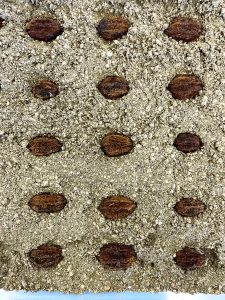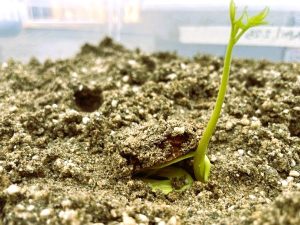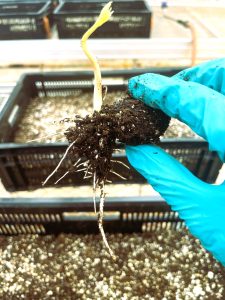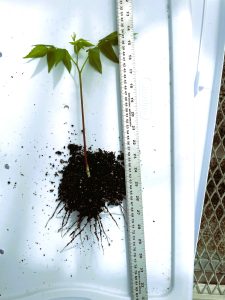Growing Hope for an Endangered, Native Tree – Vineland’s Role in Saving the Butternut
VINELAND STATION, Ontario, May 28, 2025
At Vineland Research and Innovation Centre, we are proud to contribute our horticultural expertise to a project that combines science, restoration, and hope: the recovery of Canada’s endangered butternut tree (Juglans cinerea). In collaboration with Trees for Life, a national charity that helps plant trees where Canadians live, work and play, and supported by Ontario’s Ministry of the Environment, Conservation and Parks (MECP), this initiative aims to reintroduce and restore populations of butternut across the province—one seedling at a time.
The butternut tree, a native species found throughout eastern North America, is facing severe population decline. Once a common sight in forests and rural landscapes, it is now officially listed as endangered in Canada. The primary threat is a lethal fungal disease known as butternut canker, which causes dieback, trunk girdling, and ultimately tree death. The disease has proven to be both fast-spreading and devastating, dramatically reducing natural regeneration and leaving conservationists with an urgent challenge: how to protect, propagate, and re-establish this ecologically valuable species.
As part of an initiative by MECP to improve the recovery and protection of butternut trees through urban plantings in Ontario municipalities, Trees for Life is working with municipal partners to plant up to 2,000 butternut trees in suitable habitats across Ontario. The project relies on seeds sourced from trees that have shown promising resistance to butternut canker. These seeds hold the genetic key to restoring the species. However, getting from seed to sapling is far from simple. That’s where Vineland stepped in to help.
We’ve long recognized the vital connection between plant science and environmental stewardship at Vineland. When Trees for Life approached us with the challenge of propagating these rare, high-value seeds, we saw an opportunity to apply our research capabilities to a meaningful cause. Unlike many widely cultivated tree species, germinating and growing butternut seeds remains challenging—particularly when dealing with those with unique genetic resistance traits. As a result, successful propagation requires careful experimentation, patience, and expert care.
As the winter began, our team focused on testing a range of stratification and overwintering techniques, followed by a spring of testing out several germination methods, seeking the right environmental conditions to break seed dormancy and encourage healthy root development. This included testing varying moisture controls, substrate blends, and container types to determine the best approach for seedling success.
The first of our butternut seedlings began to emerge earlier this month. Each one represents a future canopy tree that may one day offer shade, shelter, and ecological benefit in Ontario’s forests, parks, and urban greenspaces.
“We were absolutely thrilled to see the first of our babies growing,” said Dr. Rhoda deJonge, Director of Plant Responses and the Environment here at Vineland. “We’ve had excellent overwintering success and are so pleased to see this precious next generation, putting down roots and growing quickly.” “We will continue to monitor growth rates, root development, and overall plant health, gathering data that can inform broader propagation guidelines for the species. Our aim is to develop reliable, scalable techniques to support nurseries, municipalities, and conservation organizations participating in butternut restoration across Canada.” says deJonge.
This fall, our partnership with Trees for Life will enter its next phase, as several of these young trees are distributed across Ontario. Selected planting sites include a mix of urban forests, rural properties, and conservation lands—each chosen to provide the best chance of long-term establishment. With Trees for Life leading the collaboration with municipal partners and Vineland supporting the scientific underpinnings of propagation and establishment, we are combining strengths in a way that multiplies impact.
Beyond the immediate impact of growing trees, this project speaks to Vineland’s larger mission: applying scientific excellence to real-world environmental and societal challenges. As climate change, disease pressures, and biodiversity loss continue to affect our natural ecosystems, the importance of research-informed restoration strategies has never been greater.
About Vineland Research and Innovation Centre
Vineland is a uniquely Canadian, results-oriented organization dedicated to horticulture science and innovation. We deliver innovative products, solutions and services through an integrated and collaborative, cross-country network to advance Canada’s research and commercialization agenda.
Vineland is situated on treaty lands. These lands are steeped in the rich history of the First Nations including the Hatiwendaronk, the Haudenosaunee, the Anishinaabe and the Mississaugas of the Credit First Nation. Many First Nations, Métis and Inuit people from across Turtle Island live and work in Niagara today. Vineland stands with all Indigenous people, past and present, in promoting the wise stewardship of the lands on which we live.
We are an independent, not-for-profit organization, funded in part by the Sustainable Canadian Agricultural Partnership (Sustainable CAP), a five-year, federal-provincial-territorial initiative. For the latest on our research and innovation, visit www.vinelandresearch.com.
For more information, please contact:
Jayne Bintley, Senior Advisor, Communications & Marketing
jayne.bintley@vinelandresearch.com
(289) 968-5173




